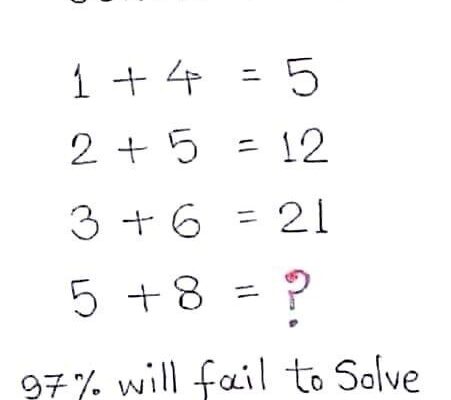Many people are baffled by a perplexing arithmetic problem that has been making the rounds on social media lately. The task consists of a sequence of arithmetic problems that appear straightforward but have a peculiar twist. Usually, the graphic says:
The pattern concealed behind the numbers is more fascinating than the actual mathematical procedures. The equations appear to violate standard arithmetic norms. A closer examination, however, exposes a deft pattern that, when recognized, makes the challenge easily solved. Let’s examine the reasoning and provide the solution to this conundrum.
Understanding that the equations follow a cumulative pattern rather than simple addition is the key to solving this puzzle. Here’s how to deconstruct it:
The first equation is 1 + 4 = 5.
At first glance, this equation appears simple because 1 + 4 does, in fact, equal 5. It does, however, lay the groundwork for the cumulative pattern.
Equation two: 2 + 5 = 12
Remember that 2 + 5 = 7 to grasp this. Nevertheless, the solution given is 12, which is 7 times the outcome of equation (5).
Thus, 7 (2 + 5) + 5 (the earlier outcome) = 12.
Equation Three plus Six equals 21.
In the same way, 3 + 6 = 9. We obtain 21 by adding this to the earlier result (12).
Thus, 12 (the prior result) plus 9 (3 + 6) = 21.
Utilizing the Pattern
Let’s apply the pattern to the last equation now that it is evident:
Equation Four: 5 + 8 =?
In accordance with the pattern, 5 + 8 = 13.
The final answer is obtained by adding this to the previous result (21).
Accordingly, 13 (5 +  + 21 (the earlier result) = 34.
+ 21 (the earlier result) = 34.
In conclusion
Using the cumulative pattern found in the earlier equations, the solution to the last equation, 5 + 8, is 34. Therefore, the difficulty lies not only in basic addition but also in comprehending and identifying the pattern that is followed to arrive at each subsequent conclusion.
This puzzle demonstrates a crucial component of problem-solving: occasionally, examining hidden patterns and searching past the obvious is necessary to get the answer. Although the test’s misleading simplicity may cause 97% of people to fail it at first, once the underlying strategy is exposed, it turns into an interesting and fun mental workout.
The Significance of Puzzles Such as These
More than just a fad on social media, puzzles and brainteasers like this one are essential for cognitive growth. They promote the ability to think critically, identify patterns, and tackle issues from several perspectives. This particular puzzle serves as an example of how decomposing difficult issues into simpler ones and looking for patterns might result in a solution—a useful ability in many facets of life.
In conclusion, 34 is the solution to the widely shared arithmetic problem “5 + 8 =?” The procedure entails adding the current values and then adding the results of the previous equation. It’s a great reminder that sometimes finding answers involves thinking creatively and searching for patterns that go beyond what is immediately apparent. Therefore, the next time you come across an issue that seems intractable, stand back and look for the hidden logic—it’s there, just waiting to be found.



